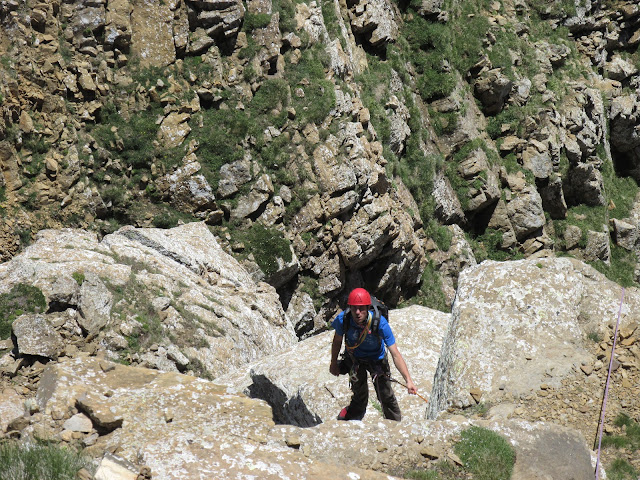Merche Route, Peña Escuach, Panticosa, Huesca, Spain
En nuestro último día de esta semana de escalada decidimos hacer algo corto, porque la idea era volver a comer a Zaragoza.
En torno a las 6 de la mañana salimos de Canfranc con direccion Panticosa, para escalar la vía Merche en la Peña Escuach, una vía equipada en el 2005 por Julio Armesto y Salvador Lopez.
On our last day of this climbing week, we decided to climb something short, because the plan was being in Zaragoza for lunch.
At about 6 o'clock we left Canfranc heading to Panticosa, to climb the "Merche route", on the Peña Escuach of Panticosa village (not the health resort), a well-equipped route opened by Julio Armesto y Salvador Lopez in 2005.
El camino se encuentra en unos raíles metálicos que ascienden pegados a una gran tubería. Tras unos 50 metros de subida, hay un pequeño hito de piedra, indicando que el camino va por debajo de la gran tubería. Tras la tubería hay un sendero que se adentra en un corto bosque. Al acabar el bosque se llega a la zona de las paredes, hay una sirga para ayudar a llegar al principio de la vía Merche.
The track is on a rail that goes next to a big pipe. After about 50 meters climb, there is a small boundary marker, where the track turns left and goes under the big pipe. Once passed the pipe there is a footpath which goes into a little forest. The wall is just at the end of the forest, there is a rope to help to reach to the base of the "Merche route".
La vía consta de 5 largos, esta muy bien equipada, con tramos que varían entre el III y 6a, con buena roca, ademas ofrece una magnificas vistas de Peña Telera, Panticosa, pico Sabocos, etc.
The route has 5 pitches it is very well equipped with many parts of different levels, between III and 6a. Also there is a magnificent view of Peña Telera, Panticosa village, Sabocos pic etc.
Largo 1: Empieza en una placa sencilla, para después realizar una travesía a la derecha que acaba en otra placa más vertical con el paso más difícil de la vía. Después se tumba un poco, hasta llegar a la reunión.
Pitch 1: The route starts on an easy slab, just after the slab there is a traverse to the right which ends at the bottom of a vertical slab where the most difficult part of the route is. The belay station is just after the slab.
Largo 2: La vía sigue por una canal entre bog.
Pitch 2: The route carries on for a groove which goes between boxwood plants.
Largo 3: Se inicia en una placa vertical (posibilidad de pasar por la derecha), luego se tumba hasta llegar a un corto muro vertical que nos deposita en la reunión.
Pitch 3: It starts on a vertical slab (there is a chance of avoiding this part going to the right), afterwards loses inclination until it gets to a short vertical wall that ends where the belay station is.
Largo 4: La via continua por una sucesión de placas, fáciles al principio, hasta llegar a un diedro, con el paso más difícil del largo, continuamos por placas más difíciles hasta la reunión.
Pitch 4: The route continues for a succession of easy slabs until it gets to a dihedral, where the hardest part of the pitch is, once the dihedral is passed there are some slabs until the belay station.
Largo 5: Consta de una placa corta pero con un paso dificil, para alcanzar la cima.
Pitch 5: It is a short but quite hard slab to get to the top
El descenso se realiza por el barranco de la derecha de la vía, hasta llegar al bosque, donde se encuentra el camino.
The descent is through the cliff set to the right of the route, heading to the forest, where there is a footpath.



















































